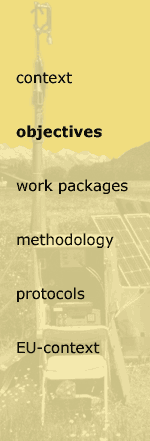

General aims of CARBOMONT
In support of the Kyoto Protocol it is the overall aim of the proposed project to quantify the sources, sinks and fluxes of carbon in non-forest European mountain ecosystems in different land use. In order to consider the different ecological, socio-economic and political background conditions at a European scale, the extended CARBOMONT project will be carried out in a total of thirteen study sites: in EU member states, Switzerland and the Newly Associated States. In each study site comparative ecosystem analyses focussing on carbon sequestration and flux partitioning in differently managed non-forest ecosystems (meadows, pastures, dwarf shrub communities and abandoned areas) are carried ou t. At least two different land-use types are investigated in each study site. Land-use changes may affect carbon flux rates considerably by modifying nitrogen availability. Therefore, interactions with the nitrogen cycle are considered as far as it affects carbon flux rates and source/sink relationships. In addition, the effects of major climate drivers (e.g. temperature and water limitations) on the above-mentioned processes are investigated. Based on these ecosystem studies, the effects of land use and climate on carbon sequestration and flux partitioning are analysed.
t. At least two different land-use types are investigated in each study site. Land-use changes may affect carbon flux rates considerably by modifying nitrogen availability. Therefore, interactions with the nitrogen cycle are considered as far as it affects carbon flux rates and source/sink relationships. In addition, the effects of major climate drivers (e.g. temperature and water limitations) on the above-mentioned processes are investigated. Based on these ecosystem studies, the effects of land use and climate on carbon sequestration and flux partitioning are analysed.
The rationale of the CARBOMONT project is to undertake ecosystem research leading to improvements in fundamental understanding of carbon sequestration in European mountain ecosystems and integration between issues and scales relevant for major European environmental policy sectors. Additionally, it will provide process-oriented research and develop scenarios at the scale of mountain landscapes. In order to keep the project to a realistic scope, the up-scaling of CO2 fluxes to the landscape scale will be confined to selected study sites of CARBOMONT (Stubai Valley, Berchtesgaden, Monte Bondone, Finish Lappland and the Slovak study site Polana).
The general aims of CARBOMONT are:
- To quantify the annual carbon balance and its variability of the major European non-forest mountain ecosystems, and how it is affected by land use and different climatic conditions
- To determine and quantify the carbon pool components and their source/sink strength in mountain ecosystems under different land use and climatic conditions
- To identify and quantify interactions between the carbon and nitrogen cycle by assessing the effects of nitrogen availability, as mediated by land use, on carbon flux rates and source/sink relationships
- To develop and adapt SVAT models for the investigated ecosystems and to use them for further analyses of the governing processes
- To develop and adapt CO2 exchange models for complex landscapes and to simulate how contrasting policy scenarios may alter landscape level carbon sequestration of selected study sites
Specific scientific objectives
Specific objectives of CARBOMONT are:
- To compare the carbon sequestration of the studied non-forest sites with already existing CO2 flux monitoring sites in adjacent forest ecosystems
- To analyse processes affecting net ecosystem carbon exchange, including the effects of differing canopy structure and functional group physiology, of soil respiration and of snow cover duration
- To understand the interactive effects between inter-annual climate variability and the timing of management practises on the annual carbon balance
- To quantify and explain the role of soil carbon in long-term carbon sequestration, in particular differences between managed and abandoned sites
- To identify which management practises, depending on land-use history and climatic conditions, act as to increase ecosystem carbon accumulation
- To quantify the spatial heterogeneity of net ecosystem CO2 exchange and to relate it to functional and morphological soil/vegetation attributes
Specific technological objectives and developments
- To test and apply a new combined approach of Eddy covariance measurements and chamber techniques for assessing CO2 exchange components in mountain areas
- To test and apply a new remote sensing technique for assessing the spatial distribution of land cover, LAI, phenology status and NPP in complex mountain landscapes
- To develop and apply new tools for the visualisation of carbon sequestration and CO2 flux partitioning, as well as landscape scenarios on the internet.
- To develop and apply a novel fluorescence imaging technique for remote sensing of the spatial distribution of assimilatory activity (see new WP 7 contributed by NAS partners)
At each study site, regional focus groups will be set up comprising CARBOMONT scientists, socio-economists and stakeholders. The focus groups will consider defined alternative policy scenarios and identify likely impacts of these scenarios on the local study site and its pattern of land use. Focus group conclusions will guide the details of the scenario development. They will help to elaborate recommendations for the sustainable rural development of mountain areas, considering both the regionally crucial questions concerning the protection of the human living space in mountain areas and global implications of long-term carbon sequestration.
